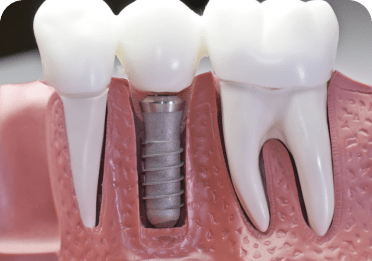Dental Implants

What are dental implants?
Dental implants are small, threaded posts that surgically replace missing teeth. In addition to filling in gaps in your smile, dental implants improve chewing function and overall oral health. Once healed, implants work much like natural teeth.
- Threaded post: You can think of this like an artificial tooth root. A provider places it in your jawbone during an oral surgery procedure.
- Abutment: This is a tiny connector post. It screws into the threaded post and extends slightly beyond your gums. It serves as the foundation for your new artificial tooth.
- Restoration: A dental restoration is any prosthetic that repairs or replaces teeth. Common dental implant restorations are crowns, bridges and dentures.
What conditions are treated with dental implants?
Dental implants treat tooth loss, which can happen due to:
- Cavities.
- Cracked teeth.
- Gum disease.
- Teeth that never develop (anodontia).
- Teeth grinding or clenching (bruxism).
How common are dental implants?
Procedure Details
What is the process of getting a dental implant?
Dental implant surgery is a personalized process. It’s not the same for everyone. But the following gives a general overview of what you can expect your dentist, oral surgeon, periodontist or prosthodontist to do:
- Place the implant surgically.
- Give you time to heal.
- Attach the post and final crown, bridge or denture.
Dental implant surgery
During dental implant surgery, your surgeon will:
- Give you anesthesia. This medication will numb your gums. If you choose sedation, your provider will give you those medications, as well.
- Create an incision. Your surgeon will make an incision (cut) in your gums. This exposes the bone underneath so your surgeon can place the implant.
- Prepare your jaw. Your surgeon will use a series of specialized instruments to create a small hole in your jawbone. They’ll widen the opening until it’s just the right size for your new dental implant.
- Place the dental implant. Next, your surgeon will carefully place the dental implant into your jaw.
- Close the incisions. Finally, your surgeon will reposition your gums and close the incision with stitches.
If your implant is near the front of your mouth, your dentist will make a temporary tooth for you to wear until you heal. That way, you won’t have a gap in your smile while you recover. If your implant is near the back of your mouth, you probably won’t need a temporary tooth. Your provider can tell you what to expect in your situation.
What Our Customers Say

Sarah M.

The installation process was smooth and hassle-free. The team was knowledgeable and friendly. I highly recommend wellnessvoyage for their excellent service.
James L.
Needs Help? Let’s Get in Touch

Our tours
Our Doctors

Dr. Elkhan IBRAHIMOV
Experience: 15 Years
Specialty: Dentist
City: Azerbaijan/Nakhchivan

Dr. Naim GÖNCÜ
Experience: 9 Years
Specialty: Dentist
City: Kutahya/Simav

Dr. Ozgur SAKARYA
Experience: 4 Years
Specialty: Dentist
City: Istanbul

Dr. Selda Akar Gömek
Experience: 5 Years
Specialty: Dentist Orthodontics Specialist
City: Bottom
